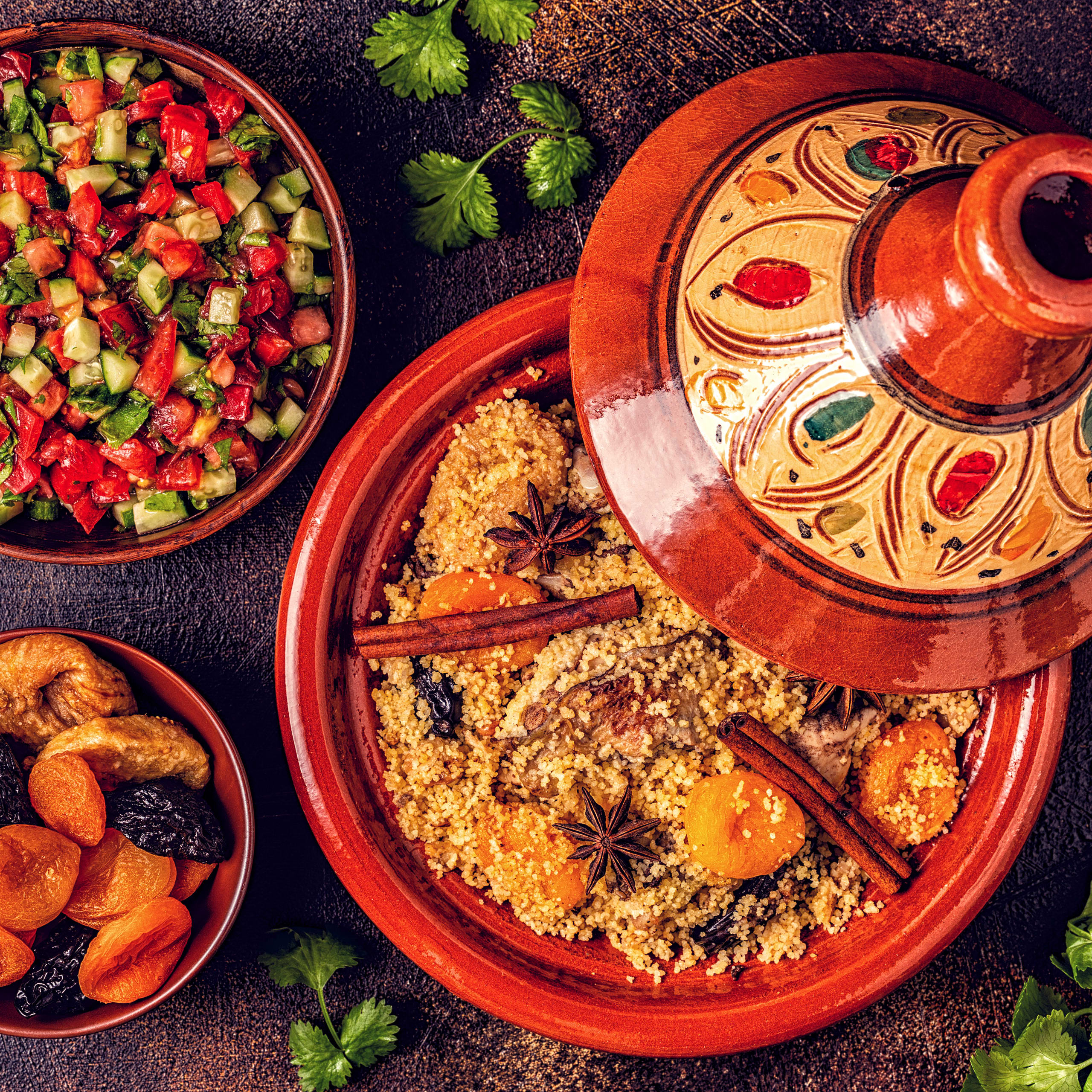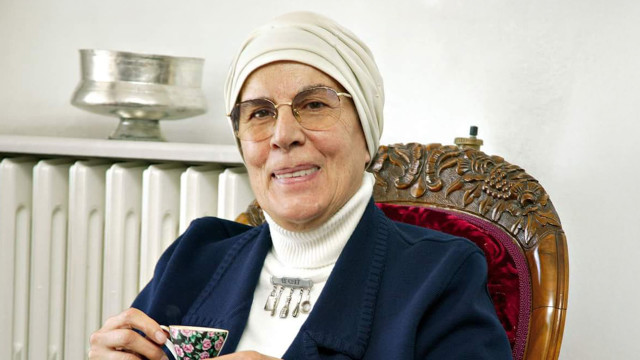Q&A with Ghillie Basan

A food anthropologist, broadcaster, and writer, Ghillie Basan has an impressive collection of 40 cookbooks to her credit, of which ten are on Moroccan cuisine. Basan has also written cookbooks on the cuisines of Kenya, the Middle East, Turkey, Lebanon, Cambodia, Indonesia, Malaysia, Vietnam, and her home turf of Scotland.
It's not hard to see why Basan’s culinary landscape is so broad. After a childhood in East Africa and her teen years in Scotland, she picked up a degree in social anthropology and a diploma from Le Cordon Bleu culinary and hospitality school in London. Basan’s travels have taken her to Africa, Europe, the United States., Southeast Asia, India, Turkey, and the Middle East, working as a travel and food writer and English teacher.
Basan has not hung up her proverbial travel boots yet, but for now home is a remote spot in the Scottish Highlands, where she continues to cook, write, and raise her children. She hosts cooking workshops, works as a broadcaster, and runs a holiday cottage and a food and whisky business called Spirits & Spice.
Her ten books that encapsulate Moroccan cooking include traditional and modern recipes, one pot cooking, and spicy stews. Basan’s books like Vegetarian Tagines & Couscous showcase the spices, herbs, vegetables, and fruits and nuts that make Moroccan food a perfect balance between simplicity and sophistication.
Roundglass Food: What drew you to dive into Moroccan cuisine and produce ten books on the subject?
Ghillie Basan: I have travelled often and extensively in Morocco and always find more to write about. It is one of those places that irresistibly draws you in with the culinary rituals, the flavors, and the generous hospitality.
RG: What are the main influences that shaped Moroccan cuisine?
GB: At the root of the culinary culture are the indigenous Amazigh, the Berber communities, with their traditions of tagines and couscous; the nomadic Bedouins from the desert who brought dates, milk and grains; the Moors expelled from Spain who relied heavily on olives and olive oil and brought with them the Andalucian flavors of paprika and herbs; the Sephardic Jews with their preserving techniques employing salt; the Arabs who introduced the sophisticated cuisine from the Middle East along with Islamic culinary restrictions; the enslaved people from West Africa with their pre-Islamic traditions; the Ottoman influence of kebabs and pastry making; and the finesse of the French.
RG: What are some traditional cooking techniques or practices used in Moroccan cuisine that promote culinary wellness?
GB: Slow cooking in tagines, the balancing of spices and the combination of fruit and vegetables in salads contribute to a healthy way of eating. Both the appreciation of the seasonal produce and culinary wellness are exemplified in the time taken to enjoy a meal, starting with little vegetable platters, olives, or nuts to whet the appetite, moving on to individual courses, and finishing with fresh, seasonal fruit.

Tagines lend to slow cooking preserving nutrients
RG: What is the role of spices and herbs in Moroccan cuisine, and how do they contribute to flavor and nutrition?
GB: Moroccan cooks use every spice that ever found its way across the Sahara Desert or over the Mediterranean, blending the influences of the different cultures that have left their culinary mark. The balancing of herbs and spices is rooted in the theory of warming or cooling the blood in order to aid digestion. Fresh herbs can also add a refreshing touch to a spicy dish.
RG: What are some Moroccan dishes that are particularly known for their health benefits?
GB: Dishes cooked in home-produced, cold-pressed, fruity olive oil and pure, nutty argan oil are regarded as healthy, as is fermented whey, lben, drunk to quench the thirst on a hot day. Dates, offered as a gift of welcome and added to some tagines, are an excellent source of energy and contain a lot of antioxidants believed to be good for the heart, the brain, and the digestion. And there are a wide variety of seasonal vegetable and pulse dishes, which are both healthy and affordable.
RG: Are there any unique cultural or social aspects associated with Moroccan cuisine that contribute to the overall wellness and enjoyment of the dining experience?
GB: To sample the best of Moroccan cuisine, it is essential to be invited into a home where the women of the household have lovingly prepared a myriad of tantalizing dishes. The presentation of the food and the eating of it are regarded as an art and a pleasure, so there is no hurry. In most homes, it is customary to eat using your hands so, at the start of a meal, a jug of perfumed water is passed around to refresh the face and fingers of the right hand. The dishes are placed in the center of the table, often in the earthenware dishes in which they were cooked, and everyone tucks in. As dish follows dish, it is vital to pace yourself and eat slowly so that you can enjoy each mouthful.
RG: What is the treasured heritage cookware that you have from Morocco?
GB: A traditional Berber mortar and pestle, made of wood and beautifully decorated.
RG: What is a Moroccan herb or elixir or tea that you associate with healing?
GB: Mint tea could be regarded as the national drink and is both healing and restorative, refreshing the palate and aiding digestions, but it is also convivial as it is offered and shared wherever you go. From a health point of view, you just need to be aware of how much sugar has been added to the pot as Moroccans do enjoy their mint tea sweet.
RG: Is there a kitchen meditation or practice in Morocco you find unique?
GB: The preparation of couscous is unique as it is of fundamental value to Moroccan culture for dietary, religious, and symbolic reasons. Moroccans believe it is a food that brings God’s blessing upon those who consume it and is, therefore, prepared in every household on Muslim holy days and on Fridays, the Islamic day of rest, when it is traditionally distributed to the poor as well. The preparation varies from region to region and is dependent on the type of granules, but it plays such an important role in the culinary life of most Moroccans that it determines the status of a cook’s ability. The word “couscous” refers to the granules as well as the finished dish, which is traditionally served as a course on its own, and should be light and airy, almost floating above the plate, and heavenly to touch and taste.
Key Takeaways
- Basan on slow cooking for nutrient preservation.
- Moroccan cuisine boosts flavors with fresh produce.
- Moroccan customs create memorable meals.



